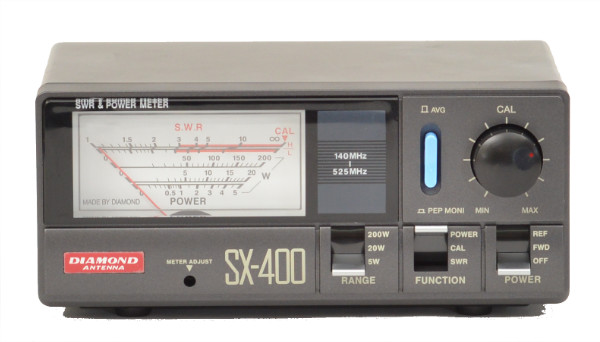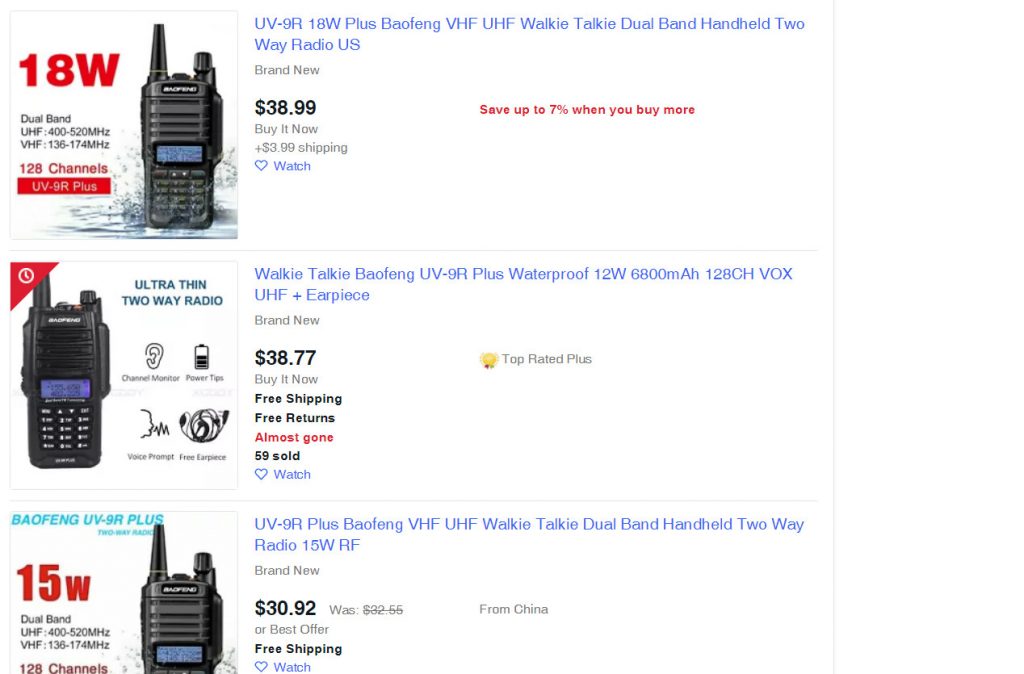There are a lot of problems with testing radios including running tests that actually mean something to the bulk of people out there and doing it in such a way that I don’t have to be rich to run them. You can easily spend hundreds of thousands of dollars on VNAs, spectrum analyzers, signal generators, and more. I just can’t do that and honestly, I don’t think that level of scientific accuracy matters to my readers.
What most people are concerned with when they come to this site is finding a radio that works for them. This means they are far more concerned with the fact that radio A outperforms radio B in every comparison and is also cheaper than they are that my equipment is off by .02 watts.
To that end, I have tried to run tests exactly the same way using the same equipment every single time so you get a good idea of how the radios stack up. Let’s take a look at how I am testing my radios…
Power output
I always test my radios on the simplex frequencies of 146.520 and 446.000 depending on what the radio can do. I remove the antenna and connect the radio to a Diamond SX-400 SWR & Power Meter.

When looking at the results for power and frequency you should be concerned with how it stacks up against other radios I have reviewed, not how it compares to the manufacturer specification. Those manufacturers hardly ever actually test at actual frequencies you use, rarely do it on battery power, and consistently round their numbers to make it easier for sales brochures.
It is not unlikely to see the same radio for sale on eBay with three different power ratings, sometimes in the same listing! Don’t believe me? Go take a look at the Baofeng UV-9R Plus on eBay
In the image above you can see the same radio advertised at three different power levels, 18w, 12w, and 15w and these were literally the first three results in a search! The one I bought was actually advertised at 10w and in the same listing said it was 5w. You just can’t rely on advertised specifications.
Add to that the fact that the radio will output different power levels at different frequencies. Looking at the UV-9R Plus, for example, my meter showed 1.5w at 446.000Mhz and 3.75w at 146.520Mhz.
Lastly, I attach the antenna that came with the radio to the output side of the meter so I see what power output is to that antenna. After all, what you want to know is what power is being output with the radio on battery power, on the frequency you are going to use, and with the antenna you will be using, otherwise, the numbers are truly meaningless.
Using the right antenna makes a difference, for example when I use a Baofeng BF-888S and the factory antenna at 446.000MHz I get .5w output, but if I swap to a Nagoya NA-771 antenna the output moves up to .9w. I can swap the antennas back and forth repeatedly and get the same numbers. A radio you might be more familiar with, the Baofeng UV-5R puts out 1.4watts at 446.000 with the stock antenna, but swap that with the Nagoya NA-771 and that jumps to 2.4watts.
The important thing to watch in this test is when comparing this radio to another radio and seeing which is more powerful. An example might be comparing the UV-9R Plus at 1.5w at 446.000Mhz to the UV-5R which puts out 3w. Then when you look at the antenna you see that the UV-9R Plus antenna at that frequency has about 18dbi of gain while the UV-5R only has 14dbi. If you remember your license test you know that effective power is doubled for every 3dbi of antenna gain and since the UV-9R Plus has 4dbi more gain than that of the UV-5R that means that the stock UV-9R Plus will transmit more effective power than the UV-5R will even though the UV-5R radio actually puts out more power to the antenna.
See why all this data matters?
NanoVNA Antenna Comparisons
When comparing the antennas that come with the radio you find some interesting tidbits, particularly when comparing them to other radios. Again, I am not running the test to really see how good an antenna is by itself, but I am comparing, for example, the antenna that came with the Yaesu-FT60R to the one that came with the Baofeng UV-5R. The results surprised me.
One very important note on the antenna tests is that in order to keep the test fair between all antennas is I tested them sitting on a wooden desk with nothing around them. This means that all of the readings are off, but hopefully, they are off by the same amount.
The reason for this is that the antenna typically is held vertically close to your head, this adds a ground plane to the antenna that is not there in my tests. Why did I do this? Because I was looking for a base level to compare, and how you hold the radio, where it is, whether you use an external microphone or not, all add to differences in the way the antenna works.
By doing the test without any type of ground plane it virtually guarantees that the antenna will perform poorer than when actually in use, but it also makes sure that every antenna tested has exactly the same deficit. This should ensure that the test results give a fair representation of how the antenna will perform when compared to any other antenna tested the same way.
Audio transmit and receive quality
One of the biggest complaints with DMR radios is that they supposedly have terrible analog FM transmit quality or level. This is also a frequent complaint on the cheap Chinese radios by people who use higher-end radios. I needed a way to test this and see how true it is.
The test I came up with was to use the radio I felt had the best receive unit of any radio I owned, my Yaesu VX-8G to receive the transmitted audio from all my radios and compare them. Here is how I did that.
I have my VX-8G with a Yaesu CT-44 adapter using a headphone cable plugged into my Yamaha MG10XU mixer, then line out into my Scarlet 6i6 audio interface. This feeds into my video/audio editing computer digitally and is recorded using Audacity. All the settings of the devices and software are recorded so I can reproduce the setup for future tests.
I then use the lowest power settings on my radios to transmit to the VX-8G on a simplex frequency which is then recorded on the computer. Initially, I did a whole lot of radios at once into the same recorded files, and then later I made sure to do a known radio before and another known radio after any radio I was testing.
Once the recordings are done I listen to the recording through a pair of Yamaha HS5 Studio Monitors as well as a pair of Audio-technica ATH-M50x headphones and try to get a subjective feel for each transmission. Using this method I can compare the transmitted sound quality and audio level of the radio in direct comparison to tons of other radios and give you a feeling of which ones are good, and which ones are not good.
These recordings are also exported as an MP3 file and attached to each review so you can hear them yourself.
For the receive audio, I do things a little differently. I use the VX-8G to transmit to the test radio which is in front of a Rode NT1-A microphone at a preset distance and volume. This is run through the mixer and audio interface just like previously.
The big difference here is that every radio is a little louder or softer at any particular volume level so I equalize the volume levels in software by using a level meter to achieve roughly the same volume levels. I can then listen to the roughly equal level recordings through the monitors and give a reasonable comparison.
Spectrum analysis
I do not own a true spectrum analyzer so I use a NooElec SDR dongle instead. It does not provide me with scientific accuracy but it will show you what the waveform looks like coming out of a radio. I was also surprised to see that new radios that I expect to be accurate because they cost a small fortune, are not necessarily as accurate as one would think.
To be completely honest, this test for me is more about showing me a reason why a radio has good or bad audio than anything else.
In Conclusion
No, none of these methods are perfect or scientifically accurate. They are however at least in my opinion, more than sufficient to give you an accurate picture of how all the radios on this site compare to each other, and that is what I am after.
I should also mention if you have a better idea on testing the radios, or a test you would like to see performed on all the radios, use the Contact link at the top of the site to drop me a line. I am always interested in ways to improve the site and bring you better and more useful information.
Remember, the bottom line here is how radio A compares to radio B on my site, not how it compares to the manufacturer’s information or to some other website where they use different equipment and methodologies. Don’t find someone on YouTube who says a radio puts out 10watts and compare it to a review of a different radio here on my site that I measured putting out 2watts. That is not an accurate comparison.

